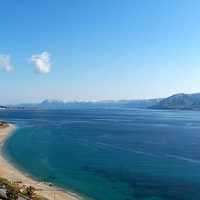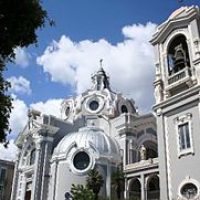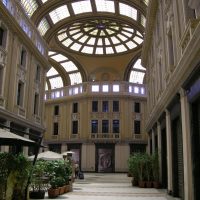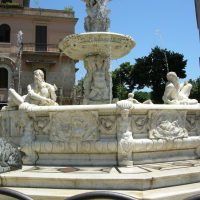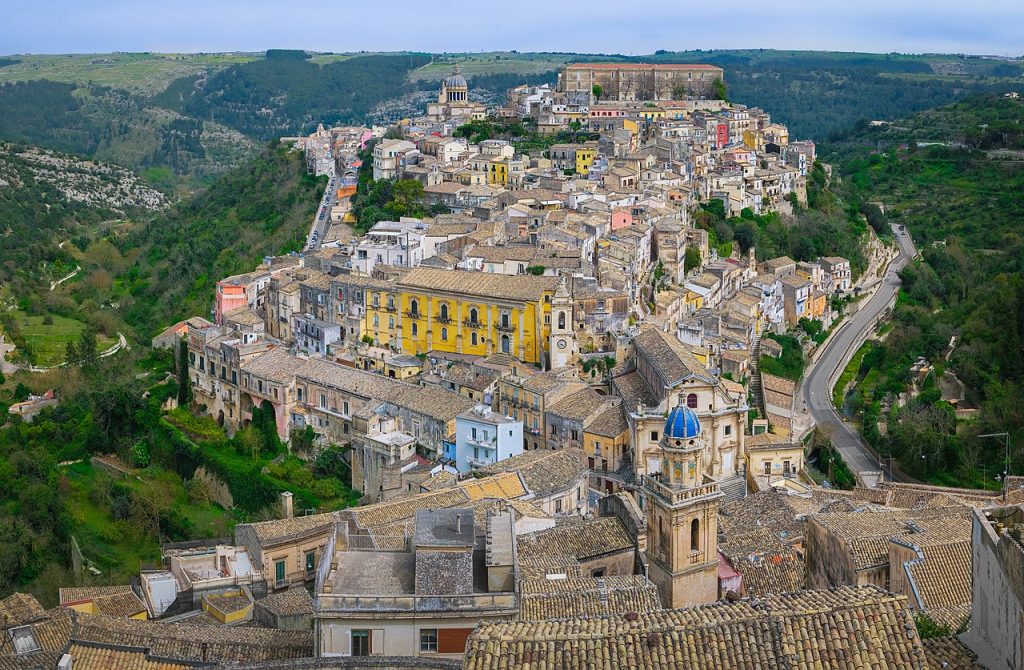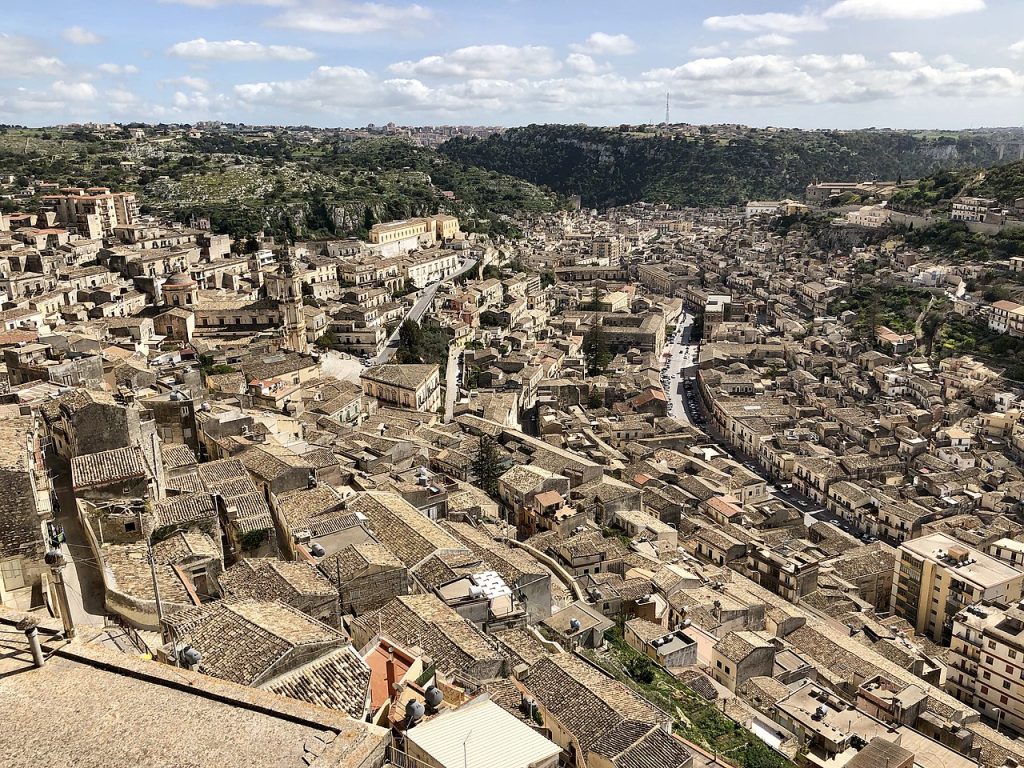Messina is an Italian town of 236 034 inhabitants capital of the homonymous metropolitan city in Sicily, as well as thirteenth Italian municipality and third largest city of the most populous region of Italy.
It rises near the extreme north-eastern tip of Sicily (Capo Peloro) on the Stretto that bears its name. Its port, ferry port for the Continent, is the first in Italy for the number of passengers in transit and tenth for cruise traffic.
Founded as a Greek colony with the name of Zancle and then Messana, Messina reached the peak of its greatness between the late Middle Ages and the mid-XVII century, when it contended in Palermo the role of Sicilian capital.
Set on fire in 1678 after a historic anti-Spanish uprising that led to the annihilation of its ruling class, it was seriously damaged by an earthquake in 1783. It was besieged in 1848, during the Sicilian revolution of 1848 against Ferdinando II di Borbone, undergoing serious damage. In 1908 a disastrous earthquake destroyed the city almost entirely, causing the death of about half the population.
Rebuilt from 1912, the modern city presents itself with a neat and regular mesh with wide and straight streets in a north-south direction.
Important and historic university building (the Studiorum Universitas was founded in 1548 by Sant’Ignazio di Loyola).
Territory
Located in the north-eastern corner of Sicily, on the western shore of the Strait of Messina (Ionian Sea) – altitude 3 meters above sea level- has a municipal area of 211.23 km².
The city develops itself mainly longitudinally along the coast of the Stretto without interruption from Giampilieri Marina to Capo Peloro for 32 km in the Ionian area. The Tyrrhenian belt, of 24 km, extends from Capo Peloro to Ponte Gallo.
Messina is at the center of an agricultural area, with the production of citrus fruits (including lemon, orange, mandarin or clementine), fruit, vegetables, D.O.C. Faro and beer (DOC 15 and Birra dello Stretto) since 2016. The city has been a university since 1548, the Archdiocese Protometropolitana of Messina – Lipari – Saint Lucia del Mela and the Archimandrite of the Santissimo Salvatore and an ancient International Fair of Messina held until 2013. The port was home to an ancient military Arsenal and is still home to shipyards Rodriquez (now Intermarine) and Palumbo one.
Monuments and places of interest
Over the centuries various destructive events, both human and natural, have devastated the city, which today has a modern appearance, especially it has the result of the latest reconstruction after the earthquake of 1908 and the bombings from 1940 to 1943. Many of works art and buildings built over the centuries have been lost, but the city still retains monumental examples of absolute importance.
Religious architecture
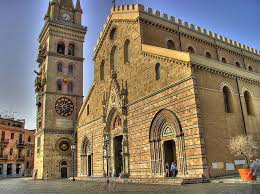
Basilica Prototropolitan Cathedral, dedicated to Santa Maria Assunta, Byzantine, rebuilt at the end of the XII century and with numerous other remakes. It preserves numerous works of art. Its foundation dates back to the Arab invasion, it was desecrated by Muslims and rededicated in 1192 to the presence of Archbishop Berzio, emperor Henry VI and his wife Costanza d’Altavilla. The splendid wooden roof, with rare astronomical representations, was destroyed in 1254 by a fire that broke out during the funeral of Corrado IV of Svevia, son of Frederick II of Svevia. Substantial changes followed one another since 1300, which enriched the cathedral with the mosaics of the apses, the portal and the façade, and distorted the original Norman appearance. Damaged in the prospect by the earthquakes of 1638 and 1783, it was almost entirely destroyed by the earthquake of 1908, which left only the apsidal part standing, however, highlighting many elements of the Norman construction. The reconstruction of the Twenties restored the original appearance and recovered part of the works of art and mosaics. Another blow to the millennial structure was inflicted by the bombings of the Second World War which destroyed part of the interior.
The current building, which is desired as close as possible to the original, keeps valuable parts outside. On the façade there is the gothic style portal and the bas-reliefs on the right side, the XV century windows and a portal attributed to Polidoro da Caravaggio. Inside the Duomo of Messina, tripartite by a double row of 13 columns, you can admire the mosaics, some funeral monuments, including that of Guidotto de Tabiatis, archbishop of Messina in the XIV century, and some statues of saints, like the valuable San Giovanni Battista by Antonello Gagini from 1525. The organ inside is also worthy of note: the second largest in Italy (the first is that of the Duomo of Milan), and the third in Europe, with 5 keyboards , 170 registers, 16,000 pipes distributed on the two sides of the transept, behind the altar, on the main door and on the triumphal arch. It is the work of Tamburini company of Crema in 1948. The bell tower, 90 meters high and with a base of about 10 meters, has on the outside the largest and most complex mechanical and astronomical clock in the world, made by a company from Strasbourg, Ungerer brothers: inaugurated in 1933, every day at noon the various statues move spectacularly to the sound of the Holy Mary of Schubert. The figures of the bell tower recall the War of the Vespers in 1282: The Lion on top represents the victorious Sicilian people on Charles d’Angiò and the Guelph army sent by the pope against Sicily; Dina and Clarenza represent the women of Messina who helped men to defend the city; the cockerel between the two female statues represents the Franco-Papal army; the church that disappears recalls the Colle della Caperrina, place of the battle of 6th and 8th August 1282, the last attempt by Charles d’Angiò to enter the city from the hills to the west. The crypt is still closed to the public. It was opened in Fai days, but still requires the restoration of the Norman flooring and lighting, which the Soprintendenza is working on, seeking funding.
The Santissima Annunziata dei Catalani church, the first name of this church was that of S. Maria di Castellamare and some historians claim that the church was founded in the XII century on the ruins of an ancient temple of Neptune. A collapse occurred in the XIII century and turned the 12-meter façade back. In the Aragonese age it was a royal chapel and at the end of the XV century it was ceded to courtiers and rich Catalan merchants by Pietro d’Aragona, hence the name of Santissima Annunziata dei Catalani. The church, given the progressive lifting of the city due to earthquakes and reconstructions, is now more than three meters below street level. The church plan is a basilica Byzantine type divided into three naves with a high dome. The exterior is framed by two orders of columns with elegant capitals and two-color inlaid arches. On the sides of the nave two walkways lead over the transept passing through elegant mullioned windows. Inside the Arab-Byzantine influences are visible. It is located in Via Cesare Battisti, in front of Lepanto Square.
Santissimo Salvatore church.
Sant’Antonio di Padova Sanctuary.
Shrine of Christ the King, has the “Bell of Christ the King” placed on top of the octagonal tower (XII century) of the sanctuary. It was merged in Padua (foundry Colbachini) and inaugurated in 1934. It has a diameter of 2.66 m, weighs over 13 tons and is the third largest bell in Italy. He played until some time ago at midday, and then to make his tolls at sunset (it varies the time depending on the time of year) in memory of the fallen Messina people of the first and second world war whose remains are kept in the shrine; due to some faults in the electromechanical system does not perform the striking. It is located on Viale Principe Umberto.
Madonna di Montalto Sanctuary.
Sant’Elia church.
San Francesco dell’Immacolata church.
San Giovanni di malta church.
Madonna delle Grazie in Grotte
Santa Maria della valle church, called “Badiazza”
San Tommaso Apostolo the old man church.
Santa Maria del Carmine church.
Santa Maria Alemanna church, founded by Teutonici Knights, order desired in Messina by Federico II of Svevia, dated back in XIII century.
Other churches were destroyed during 1908 earthquake:
Messina Synagogue
Santissima Annunziata church
Santa Maria della Scala church
San Gregorio church
Anime del Purgatorio church
Santa Teresa church
Civil Architectures
Palazzo Zanca seat of the town hall, in piazza Unione Europea, was once placed at the center of the Palazzata which served as a continuum of XVII century buildings that framed the falcate port. The building was severely damaged by the earthquake of 1783, and destroyed by the earthquake of 1908, it was set back in its current position. The reconstruction work began in December 1914 under the direction of the architect Antonio Zanca and ended in 1924. The construction is in neoclassical style and covers an area of about 12,000 m². On the façade you can see some sculptures related to the symbolism of the town and numerous gravestones that recall the most important events. On the façade of via San Camillo there are two bas-reliefs depicting Dina and Clarenza, while on the opposite side, in via Consolato del Mare, there is a porticoed entrance with the Senatorial fountain of 1619 in front. The back side overlooks Corso Cavour and Piazza Antonello with a portico decorated with bas-reliefs by local craftsmen.
Vittorio Emanuele III Gallery one of the few examples of architecture using the iron of Southern Italy, the only one with Naples, Galleria Umberto I. Made in 1929 by Camillo Puglisi Allegra to complete Piazza Antonello. The portico that overlooks the square is characterized by a large arch that marks the access to the Gallery, richly decorated inside with beautiful stuccos and a black and white mosaic floor. Two flights of stairs on one side and a portico on the other, lead to secondary exits.
Vittorio Emanuele II Theater its construction was ordered on 2nd October 1838 by Ferdinand II of Bourbon and began only on 23th April 1842. It was designed by architect Pietro Valente and inaugurated on 12th January 1852, it was named to Saint Elisabeth, in honor of the mother of the sovereign. On 13th September 1860 with the Unification of Italy assumed the current name. The façade of the theater has a portico that allowed the passage of carriages that accompanied the spectators. On the entrance loggia a sculptural group of 1847 realized by Saro Zagari, depicting the time that discovers the truth. The exterior in Syracus stone is in neoclassical style, and is rich in decorations, sculptures and bas-reliefs of the Zagari representing scenes from the life of Hercules and portraits of sixteen famous dramatists and famous musicians. On the evening of 27th December 1908 Giuseppe Verdi’s Aida was represented, and a few hours later the earthquake destroyed the city, saving the perimeter of the building and the decorative parts. In 1982 began a restoration finished in December 1985, the inauguration took place on 25th April of the same year with a concert conducted by Maestro Giuseppe Sinopoli. The internal decoration of the ceiling bears the name of Renato Guttuso, the myth of Colapesce. It is located in Via Garibaldi.
Palazzo Piacentini it was a work of the architect Marcello Piacentini, located in piazza Maurolico opposite that of the University, it was built in 1927 on the areas of the old Grande Ospedale. It consists of three buildings connected by galleries that connect the three large rooms of invitation. The architecture is strongly characterized by the use of Sicilian materials. The stone, of warm yellow-ocher color, is the same one that had been used in ancient times for the temples of Selinunte and Agrigento, while in marble of Cinisi there are some ornamental parts. The choice of these island stones, especially those of the façade, was made to accentuate the Greek appearance of the whole as a reminder of the Greek temples in Sicily. The façade, surmounted by large staircases, is characterized by large and fluted half-Doric columns that frame the walls, where rectangular windows open up, and support an entablature. The windows are surmounted by rosettes and low relief medallions. The facades, main and sides, the interior are adorned with works by various artists, all in tune with the palace style, which reflects the orientation of the official act of the first twenty years of the century. The great rounds of the attic, representing Jurisprudence and Law are by the sculptor Giovanni Prini, the four Roman eagles are from Cloza and Bonfiglio; still by Cloza and Ricciardi are medallions depicting some Messinese jurists (Dicearco di Messina, Guido Delle Colonne, Giacomo Macrì, Antonio Fulci, Francesco Faranda and Andrea Di Bartolomeo); the Minerva heads on the side doors are by Monescalchi. On the grandiose attic there is finally the large quadriga led by the goddess Minerva created by Ercole Drei in bronze and aluminum alloy, probably inspired by the XIX century architectural tradition of Northern Europe. In the vestibule, at the end of which the marble staircase of honor rises, with bronze inserts, opens the marble portal that gives access to the Court of Assizes. In the halls of the audience there are allegorical bas-reliefs and in the other halls of representation, in the library, council chamber, cabinets of presidents and judges, the ceilings are decorated with greasy tempera.
University building destroyed and razed to the ground by the earthquake of 1908, it was rebuilt in 1920 and occupies an area of about 20,000 m². The university building complex was designed by architect Giuseppe Botto. After the last war, in relation to the expansion plan of the universities, the university administration arranged the elevation of some pavilions and the construction, designed by Ing. prof. Francesco Basile, of a modern building facing in Via dei Verdi. The façades of the three buildings overlooking Piazza Salvatore Pugliatti reveal neoclassical characters with floral decorations. Next to the pavilions that – under the street level – overlook the Via Giacomo Venezian is the beautiful portal of the ancient Jesuit college, the first university in Messina and the first of the Sicilian religious organizations of the followers of Sant’Ignazio di Loyola.
Palazzo delle Poste designed by Vittorio Mariani in 1915, with a clear Liberty array, it contains rich floral decorations, symbols of the city, even contemporary ones such as ferry boats, and a stucco frieze depicting postman angels and telephonists, located in Piazza Antonello. It is today one of the university’s decentralized offices.
Government Palace built in 1920 on a project by the architect Cesare Bazzani. He occupied almost the entire area of the XVI century church of S. Giovanni dei Cavalieri of Malta, of which only the magnificent Tribuna remains on the back of the Palace. It is of post-floral style with evident inserts of renaissance elements and is enhanced by a dense plasticism.
Chamber of Commerce Palace built after the earthquake of 1908 on a project by the Messina architect Camillo Puglisi Allegra. This building is divided into three floors with a classical layout, with a play of advanced bodies on the façade, punctuated by pilasters that rise up on another ashlar base to support a modulated trabeation. The third floor, built above it, has altered the system which, despite the verticality of the windows, was markedly horizontal.
Palazzo della Provincia, or “Palazzo dei Leoni” built in 1915, it rises in the same place that it occupied before 1908, previously area of the ancient church of San Nicolò dei Gentiluomini. Started in 1915, the works continued during the First World War, and, although in imaginable difficulties, were directed by the architect Alessandro Giunta. The building was inaugurated in 1918, with a ceremony in keeping with the serious moment of Italy after Caporetto, that is with the intervention of the Milan hero Luigi Rizzo, a veteran of “Buccari’s joke” and of the sinking of the “Szent Istvàn” battleship”. The building has two façades: on the Corso Cavour one opens the entrance hall preceded by a portico, on the Piazza Antonello the façade – also a portico on the ground floor – follows with its concavity the shape of the square on which it overlooks. The interiors are decorated by the caryatids and the glossy stuccos of the council chamber of D’Arrigo and Loverti and the panels painted by Corsini over the large windows of Di Stefano and Bonsignore.
Palazzo della cultura or Palacultura, inaugurated in June 2009, in Viale Boccetta. It hosts, among other things, the Contemporary Art Gallery inaugurated on the evening of 25th February 2012 on the occasion of the Night of Culture 2012 edition. Inside there is a large auditorium where they often perform among the best interpreters of classical music, there are organized in fact the cycles of concerts of both the Filarmonica and the Ass. Laudamo.
Messina Central Station & Messina Marittima Station built in 1939 by the architect Angiolo Mazzoni, after the previous demolition was carried out by order of Benito Mussolini, in which the same duke participated, pitting the old station. It was inaugurated on 28th October 1939. In a rationalist style, built using travertine, lava stone, Syracuse stone and the red stone of Taormina. The stations are divided into two bodies, the station “Marittima” and “Centrale”, the central has a large portico that leads into an olle, has a large underpass that leads to 8 tracks plus two more commercial. After the central station there are the offices of the Ferrovie dello Stato and after the offices, there is the large maritime station, this has an arched shape, on the ground floor there are the bar, the ticket office and the tabacco shop and from escalators and stairs in masonry it can go up on the panoramic saloon on the port and on the opposite wall there is a large mosaic work by Michele Cascella, restored, and represents Mussolini’s speech in Palermo. The pedestrian crossing points open for the 5 pots. From some ramps you can climb above the ship with cars. Another characterizing structure is the water tower with the spiral staircase around the structure. The station also has the interchange tasks with: the Messina tram, bus and Pullman station between the Sicily and the Continent. Inside the station there is Piazza repubblica in which we confined a fountain of 1905, desired by Mussolini.
Monumental fountains
Orione Fountain
Neptune fountain
Falconieri fountain
The four fountains
Bios fountain
Piazza Cairoli fountain
Traditions and Folklore
Good Friday winds through the main streets of the city the procession of the Barette (Varette), dating back to 1610 and consists of eleven statuary groups depicting episodes of the Passion of Christ. This procession took place several times for more than 150 years and owes the name of Barette to the fact that in the early editions there was only the statue of Madonna Addolorata and a fercolo with the dead Christ and five biers representing the Mysteries. Among the last interruptions that lasted a few years for the earthquake of 1908 and the period of the Second World War. Over the years, other simulacrums have gradually been added up to today’s twenty-one. Among the most representative the Ultima Cena which is the heaviest of the biers, and certainly the Madonna Addolorata. The procession always follows the same path marked now for about a century except for some very rare changes for exceptional events such as the year that paid homage to the Santa Eustochia. The biers remain in the Oratory of Peace which has a portal dating back to the pre-earthquake period.
On Corpus Domini day, a long procession unfolds from the Cathedral, preceded by hooded believers called “Babaluci” and by all the associations, congregations and religious brotherhoods of the city. Together with the monstrance with the SS. Sacramento, brought under a rich silk canopy by the Archbishop, is carried on the shoulder of the “Vascelluzzo” (small vessel), a fercolo in chiselled silver adorned with small red drapes and ears of wheat. The work is a vow made by the Messina people as a sign of thanksgiving to Madonna della Lettera who, on the occasion of various famines, miraculously brought some vessels loaded with grain to the city’s port. The Vascelluzzo is kept in the Church of the Sailors and is exposed behind a safety glass as well as two heavy overexposed iron grates. The morning of Corpus Domini is carried on the shoulders of 16 people, with a pace that makes it seem that the Vascelluzzo sail in the sea, and enters the Cathedral at the stroke of midday. Once arrived at the main altar, the relic of the Hair of Holy Mary is placed at the center of the vascelluzzo. In the evening after the Mass, the Vascelluzzo without the relic is reported in procession to the Church of the Sailors where he is greeted with fireworks.
The Assumption procession
The most important festival, however, is that which takes place in August each year: it is carried in procession by thousands of faithful, dressed in white and blue and barefoot, an ancient votive machine: the Vara, depicting the phases of the Assumption of the Virgin Mary to heaven. The procession attracts numerous visitors every year.
The Vara, about 13 meters and a half high, rests on large metal slides and presents numerous figures in different materials of angels, the two large rotating spheres of the Sun and the Moon and, at the top, the statue of Christ who, with one hand, sustains Mary, in the act of bringing her to the Empyrean; the faithful drag it pulling the long cables (230 m each, thickness 5 cm) that are attached to the base along the previously wet pavement of Corso Garibaldi, from Piazza Castronovo to Via I Settembre and then from Via I Settembre, historical arterial of the city, up to Piazza Duomo, where the procession ends in the evening. From 23.00 a great fireworks display, visible from the entire Stretto, closes the whole day of the party.
La Vara is a triumphal car, built for the first time in 1535, in honor of Emperor Charles V, in that year visiting Messina. In June 1575 a plague epidemic broke out in Messina that lasted about thirty years, causing the death of over 40,000 people. The disease was brought by Levante after the battle of Lepanto (7th October 1571) and soon spread to Reggio Calabria and other coasts of Calabria, including Palmi (although in a minor way). The citizens of Palmi welcomed those who fled from the Peloritan city and also, through its sailors, sent aid by means of food and oil. After the calamity, the city of Messina as a sign of gratitude towards the Calabrian town, with the resolution of the city Senate wanted to donate to the ecclesial authorities of Palmi, as a sign of thanks for the aid given, one of the Holy Mary’s hair that were brought to the Sicilian city in 42 a. C. together with a letter of blessing and protection from the mother of Christ. On 11th January 1582, accompanied during the crossing by a multitude of boats “dressed up for party”, Giuseppe Tigano’s boat brought from Messina to the Marina of Palmi a reliquary containing the Holy Heat.
In the days before 15th August, the streets of the city are crossed by the festive procession of the two Giants and the Camel, along with numerous folk groups. In particular, the two colossal statues on horseback depict the legendary founders of the city, the Messinese Mata and the Moro Grifone (called “u giganti and a gigantissa“).
The statues derive from the processional giants of the ancient Catalan tradition, still present in many areas of Catalonia and used during various festivities, such as Tarragona for the feast of Santa Tecla, or during the fiesta Mayor de Reus which takes place on the day of St. Peter Reus. The contact with the Catalan domination sent the tradition of the processional giants that has spread also in Sicily and today is linked to the cult of the Virgin Mary, as in the case of the giants Mata and Grifone of the party of the Assumption in Messina and the giants Kronos and Mytia of the feast of Holy Mary of the light of Mistretta, while the Camel recalls the triumphal entry to Messina, at the beginning of the conquest of Sicily subtracted from the Arabs, of the Norman Count Ruggero d’Altavilla, which according to tradition took place on the back of a camel.
Museums
Cultural Museum and Folk Music of Peloritans
The Cultural Museum and Folk Music of Peloritani, inaugurated in 1996 in the “Gesso” district of the northern area of the city. It is open every Sunday, or during the week by reservation. Unique in its kind in Sicily, it bases the museum layout on the criterion of multidisciplinarity: video, hypertext, digital listening, animation with traditional musicians and singers, literary, photographic, iconic, didactic and didactic supports. It houses all the musical instruments of the Peloritan tradition, including the zampogna (ciarameddi in dialect), the reed flutes (friscaletti), drums and tambourines, harpers, shells and a rich photographic documentation.
Quasimodo Archive
Archive – permanent exhibition on Salvatore Quasimodo “Life is not a dream”
Collects in a permanent exhibition manuscripts, documents, photographs, publications, honors from Salvatore Quasimodo Archive, acquired by the Regional Province of Messina. The exhibition, aimed at enhancing the fundamental aspects of the life and works of Salvatore Quasimodo (who lived most of his life in the city of the Strait), is divided into nine sections where some significant works of the poet are exhibited, as well as the translator, art critic, the theater critic and even the librettist of musical works. In support of the important artistic heritage there are numerous photographs, autographs and illustrations. It is located inside the premises of the Provincial Gallery of modern and contemporary art in via XXIV Maggio.
Duomo Treasure
The Treasure of the Cathedral of Messina, guarded and displayed in the added body on the south side of the temple, is a rich collection of precious cult objects that belonged to the Cathedral since the Middle Ages, mostly silver work by the renowned Messina goldsmith’s school. The most precious piece of the Treasure is the so-called “Manta d’oro“, a precious coating of the painting of the Madonna della Lettera in large parties, all of finely chiselled gold with floral and geometric motifs; it is the work of the Florentine goldsmith Innocenzo Mangani, who executed it in 1668. The Treasury also houses a very rich collection of vestments and sacred objects; here too the works of goldsmiths and silversmiths stand out.
Municipal aquarium
Located on the northern side of the central “villa Mazzini”, it was built in the late fifties by the thalassographic institute of the CNR of Messina. The aquarium, later passed to the municipal property, today houses 22 Mediterranean tanks and 8 aquariums that reproduce aquatic environments of the world about 100 species of fishes. There is a marine fauna museum attached to it. It born from an idea, dated 1868, of the German naturalist Anton Dohrn to observe and study the fauna of the Stretto. The Messina aquarium, the only structure of this kind in Sicily, is part, together with Milan, Naples, Livorno and Trieste, of the small group of historic Italian aquariums. Inside there are endemic species of the Stretto of Messina, unique in the world.
“Cambria” zoological museum
The “Cambria” zoological museum, belonging to the Department of Animal Biology and Marine Ecology of the Faculty of Mathematical, Physical and Natural Sciences of the University of Messina, is located in the departmental areas of the university district of Sperone, in the northern part of the city. Of considerable naturalistic interest, it preserves rich collections of vertebrates, insects and mollusks, with particular reference to the fauna of the Stretto of Messina.
“Pietro Castelli” Botanical Garden
Founded in 1638, it is one of the three Sicilian botanical gardens. It is located at the intersection of the ring road and the Via Pietro Castelli.
Historical Museum of the permanent fortification of the Stretto of Messina
The Historical Museum of the permanent fortification of the Stretto of Messina, founded in 2003 under the patronage of the Municipality of Messina and UNESCO, is housed in the premises of the Forte Cavalli one of the many built on both sides of the Stretto around 1890 to defend the arm of sea from a feared French invasion. The exhibition itinerary, starting from the ballistic studies of General Giovanni Cavalli, inventor of the rifling of cannons, tells the story of the defense of the Stretto from the post-unification period to the Second World War through iconographic tables and objects belonging to the structure. The fort also houses the largest Italian cannon of the Second World War (16 tons per 10 meters in length), donated by the Ministry of Defense and declared a Monument to the Fallen of all Wars.
Pupi Show
Hundreds of Pupis and manuscripts of the late XIX and early XX centuries are on display, heads and canvases by Vasta and Marino, a series of tools for the construction of the “pupi“, sets, and photos of the shows.
Food
In Messina typical food, we can find dishes with fish, in particular with seafood, like swordfish, salted codfish, mussels, saris, baby fish and tuna. By talking about meat, we will find pork chops and falsomagro. The typical Messina desserts are: the sweets pignolata, the white and black, the ricotta cannoli with chocolate, the Sicilian cassata. The Messina focaccia are also typical foods, with inside endive with peppered anchovy and Tuma cheese, the bread alla disgraziata, savory pies (arancini, pidoni, mozzarella in carrozza and puff pastry) and the granita, in different taste (strawberry, lemon, almond, mulberry, chocolate, pistachio and the granita coffee and cream) combined with the brioche which very different in tasta and shape then the Northern ones. The dishes linked to Liturgical traditions are : the Pidoni (is like a calzone stuffed with white endive, anchovy and scamorza, they are usually prepared the 25th March for the Annunciation day, but also during other feasts like Saint Joseph day, Easter Monday, Immaculate Conception day, Christmas Eve, Saint Stephen day). The ciusceddu (with mince beef, calf bone, ricotta, eggs, breadcrumbs, Mallorca cheese, tomato, onion, celery and parsley) it was a typical Easter dish and the pasta ‘ncaciata (ingredients: beef, chicken, liver, mince beef, egg, Sant’Angelo di Brolo salami, scamorza, pecorino cheese, breadcrumbs, aubergines, tomato sauce, onion, short pasta, parsley, basil, lard, salt and black pepper). This typical dish it was usually prepared the Assumption day, the 15th August, which is the main feast in Messina.
